Tesco's Business Environment: Stakeholder Analysis and Performance
VerifiedAdded on 2023/06/10
|12
|3770
|104
Report
AI Summary
This report provides a comprehensive analysis of Tesco's business environment, covering various organizational types, key stakeholders, and their influences. It delves into the imperative reasons for analyzing the business environment using the PESTEL framework and Porter's Five Forces model. The analysis includes political, economic, social, technological, and legislative factors affecting Tesco, as well as an evaluation of the bargaining power of buyers and suppliers. Furthermore, the report evaluates Tesco's key performance indicators, considering both short-term and long-term financial and non-financial measures, providing a holistic view of the company's strategic positioning and operational effectiveness. Desklib offers a platform for students to access this and other solved assignments, enhancing their understanding of business concepts.
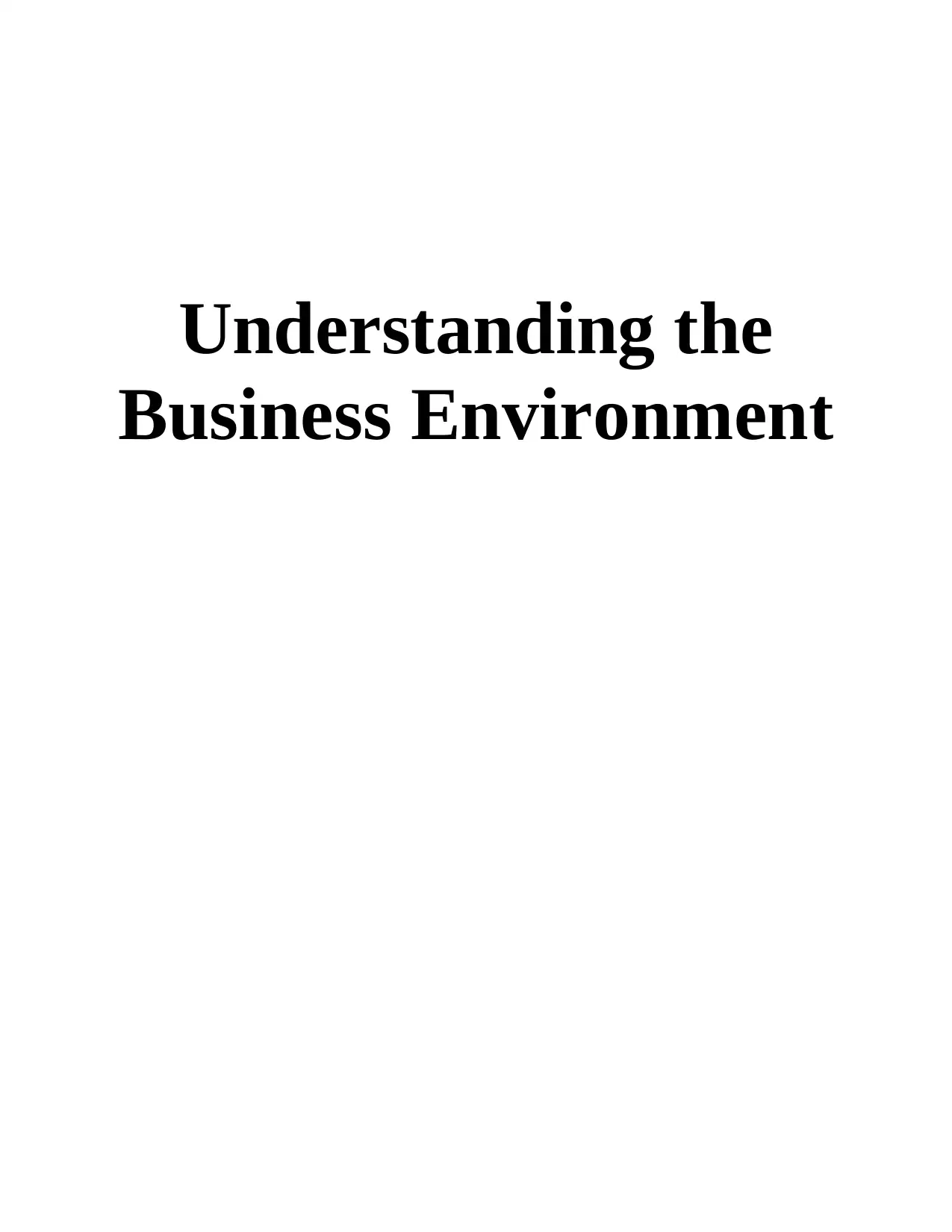
Understanding the
Business Environment
Business Environment
Paraphrase This Document
Need a fresh take? Get an instant paraphrase of this document with our AI Paraphraser
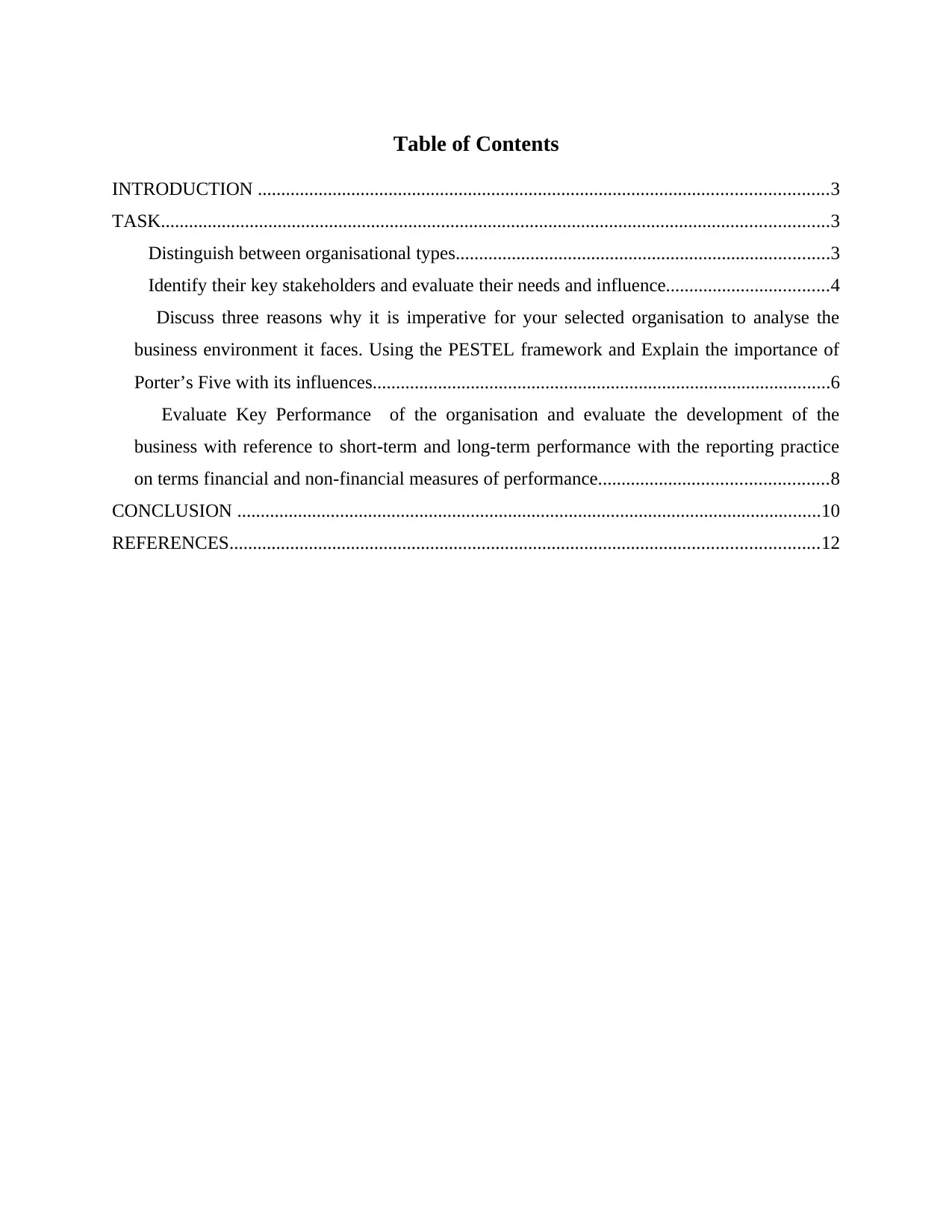
Table of Contents
INTRODUCTION ..........................................................................................................................3
TASK...............................................................................................................................................3
Distinguish between organisational types................................................................................3
Identify their key stakeholders and evaluate their needs and influence...................................4
Discuss three reasons why it is imperative for your selected organisation to analyse the
business environment it faces. Using the PESTEL framework and Explain the importance of
Porter’s Five with its influences..................................................................................................6
Evaluate Key Performance of the organisation and evaluate the development of the
business with reference to short-term and long-term performance with the reporting practice
on terms financial and non-financial measures of performance.................................................8
CONCLUSION .............................................................................................................................10
REFERENCES..............................................................................................................................12
INTRODUCTION ..........................................................................................................................3
TASK...............................................................................................................................................3
Distinguish between organisational types................................................................................3
Identify their key stakeholders and evaluate their needs and influence...................................4
Discuss three reasons why it is imperative for your selected organisation to analyse the
business environment it faces. Using the PESTEL framework and Explain the importance of
Porter’s Five with its influences..................................................................................................6
Evaluate Key Performance of the organisation and evaluate the development of the
business with reference to short-term and long-term performance with the reporting practice
on terms financial and non-financial measures of performance.................................................8
CONCLUSION .............................................................................................................................10
REFERENCES..............................................................................................................................12
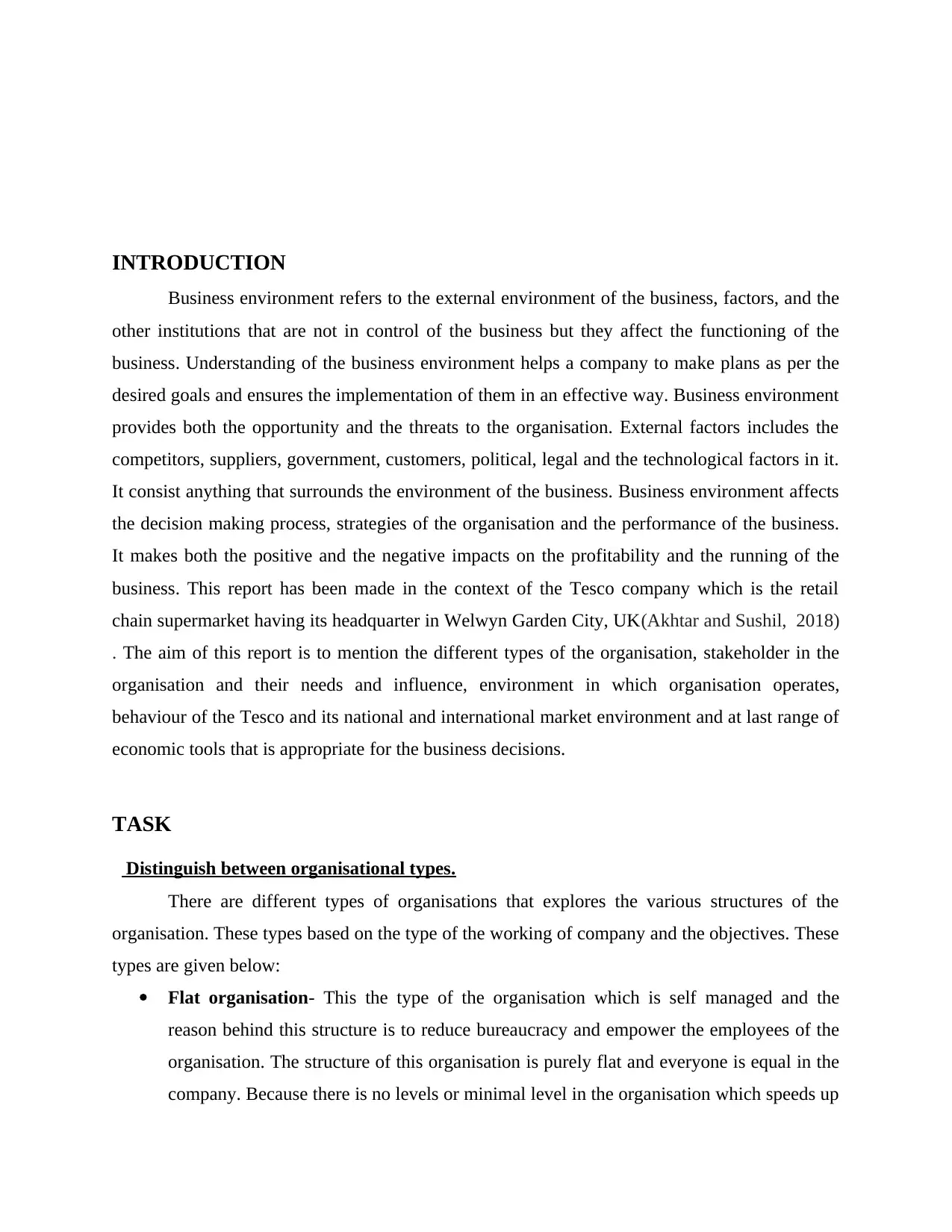
INTRODUCTION
Business environment refers to the external environment of the business, factors, and the
other institutions that are not in control of the business but they affect the functioning of the
business. Understanding of the business environment helps a company to make plans as per the
desired goals and ensures the implementation of them in an effective way. Business environment
provides both the opportunity and the threats to the organisation. External factors includes the
competitors, suppliers, government, customers, political, legal and the technological factors in it.
It consist anything that surrounds the environment of the business. Business environment affects
the decision making process, strategies of the organisation and the performance of the business.
It makes both the positive and the negative impacts on the profitability and the running of the
business. This report has been made in the context of the Tesco company which is the retail
chain supermarket having its headquarter in Welwyn Garden City, UK(Akhtar and Sushil, 2018)
. The aim of this report is to mention the different types of the organisation, stakeholder in the
organisation and their needs and influence, environment in which organisation operates,
behaviour of the Tesco and its national and international market environment and at last range of
economic tools that is appropriate for the business decisions.
TASK
Distinguish between organisational types.
There are different types of organisations that explores the various structures of the
organisation. These types based on the type of the working of company and the objectives. These
types are given below:
Flat organisation- This the type of the organisation which is self managed and the
reason behind this structure is to reduce bureaucracy and empower the employees of the
organisation. The structure of this organisation is purely flat and everyone is equal in the
company. Because there is no levels or minimal level in the organisation which speeds up
Business environment refers to the external environment of the business, factors, and the
other institutions that are not in control of the business but they affect the functioning of the
business. Understanding of the business environment helps a company to make plans as per the
desired goals and ensures the implementation of them in an effective way. Business environment
provides both the opportunity and the threats to the organisation. External factors includes the
competitors, suppliers, government, customers, political, legal and the technological factors in it.
It consist anything that surrounds the environment of the business. Business environment affects
the decision making process, strategies of the organisation and the performance of the business.
It makes both the positive and the negative impacts on the profitability and the running of the
business. This report has been made in the context of the Tesco company which is the retail
chain supermarket having its headquarter in Welwyn Garden City, UK(Akhtar and Sushil, 2018)
. The aim of this report is to mention the different types of the organisation, stakeholder in the
organisation and their needs and influence, environment in which organisation operates,
behaviour of the Tesco and its national and international market environment and at last range of
economic tools that is appropriate for the business decisions.
TASK
Distinguish between organisational types.
There are different types of organisations that explores the various structures of the
organisation. These types based on the type of the working of company and the objectives. These
types are given below:
Flat organisation- This the type of the organisation which is self managed and the
reason behind this structure is to reduce bureaucracy and empower the employees of the
organisation. The structure of this organisation is purely flat and everyone is equal in the
company. Because there is no levels or minimal level in the organisation which speeds up
⊘ This is a preview!⊘
Do you want full access?
Subscribe today to unlock all pages.

Trusted by 1+ million students worldwide
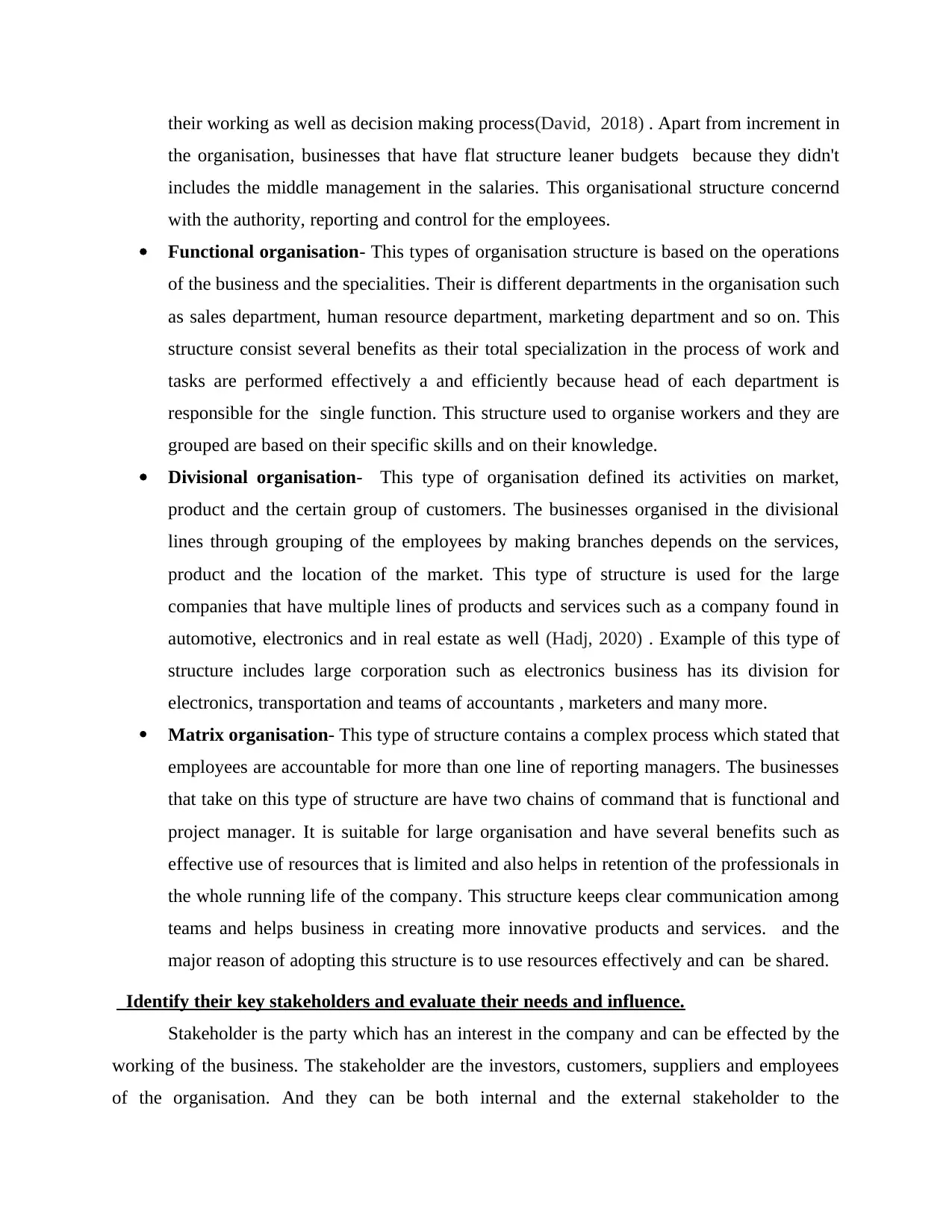
their working as well as decision making process(David, 2018) . Apart from increment in
the organisation, businesses that have flat structure leaner budgets because they didn't
includes the middle management in the salaries. This organisational structure concernd
with the authority, reporting and control for the employees.
Functional organisation- This types of organisation structure is based on the operations
of the business and the specialities. Their is different departments in the organisation such
as sales department, human resource department, marketing department and so on. This
structure consist several benefits as their total specialization in the process of work and
tasks are performed effectively a and efficiently because head of each department is
responsible for the single function. This structure used to organise workers and they are
grouped are based on their specific skills and on their knowledge.
Divisional organisation- This type of organisation defined its activities on market,
product and the certain group of customers. The businesses organised in the divisional
lines through grouping of the employees by making branches depends on the services,
product and the location of the market. This type of structure is used for the large
companies that have multiple lines of products and services such as a company found in
automotive, electronics and in real estate as well (Hadj, 2020) . Example of this type of
structure includes large corporation such as electronics business has its division for
electronics, transportation and teams of accountants , marketers and many more.
Matrix organisation- This type of structure contains a complex process which stated that
employees are accountable for more than one line of reporting managers. The businesses
that take on this type of structure are have two chains of command that is functional and
project manager. It is suitable for large organisation and have several benefits such as
effective use of resources that is limited and also helps in retention of the professionals in
the whole running life of the company. This structure keeps clear communication among
teams and helps business in creating more innovative products and services. and the
major reason of adopting this structure is to use resources effectively and can be shared.
Identify their key stakeholders and evaluate their needs and influence.
Stakeholder is the party which has an interest in the company and can be effected by the
working of the business. The stakeholder are the investors, customers, suppliers and employees
of the organisation. And they can be both internal and the external stakeholder to the
the organisation, businesses that have flat structure leaner budgets because they didn't
includes the middle management in the salaries. This organisational structure concernd
with the authority, reporting and control for the employees.
Functional organisation- This types of organisation structure is based on the operations
of the business and the specialities. Their is different departments in the organisation such
as sales department, human resource department, marketing department and so on. This
structure consist several benefits as their total specialization in the process of work and
tasks are performed effectively a and efficiently because head of each department is
responsible for the single function. This structure used to organise workers and they are
grouped are based on their specific skills and on their knowledge.
Divisional organisation- This type of organisation defined its activities on market,
product and the certain group of customers. The businesses organised in the divisional
lines through grouping of the employees by making branches depends on the services,
product and the location of the market. This type of structure is used for the large
companies that have multiple lines of products and services such as a company found in
automotive, electronics and in real estate as well (Hadj, 2020) . Example of this type of
structure includes large corporation such as electronics business has its division for
electronics, transportation and teams of accountants , marketers and many more.
Matrix organisation- This type of structure contains a complex process which stated that
employees are accountable for more than one line of reporting managers. The businesses
that take on this type of structure are have two chains of command that is functional and
project manager. It is suitable for large organisation and have several benefits such as
effective use of resources that is limited and also helps in retention of the professionals in
the whole running life of the company. This structure keeps clear communication among
teams and helps business in creating more innovative products and services. and the
major reason of adopting this structure is to use resources effectively and can be shared.
Identify their key stakeholders and evaluate their needs and influence.
Stakeholder is the party which has an interest in the company and can be effected by the
working of the business. The stakeholder are the investors, customers, suppliers and employees
of the organisation. And they can be both internal and the external stakeholder to the
Paraphrase This Document
Need a fresh take? Get an instant paraphrase of this document with our AI Paraphraser
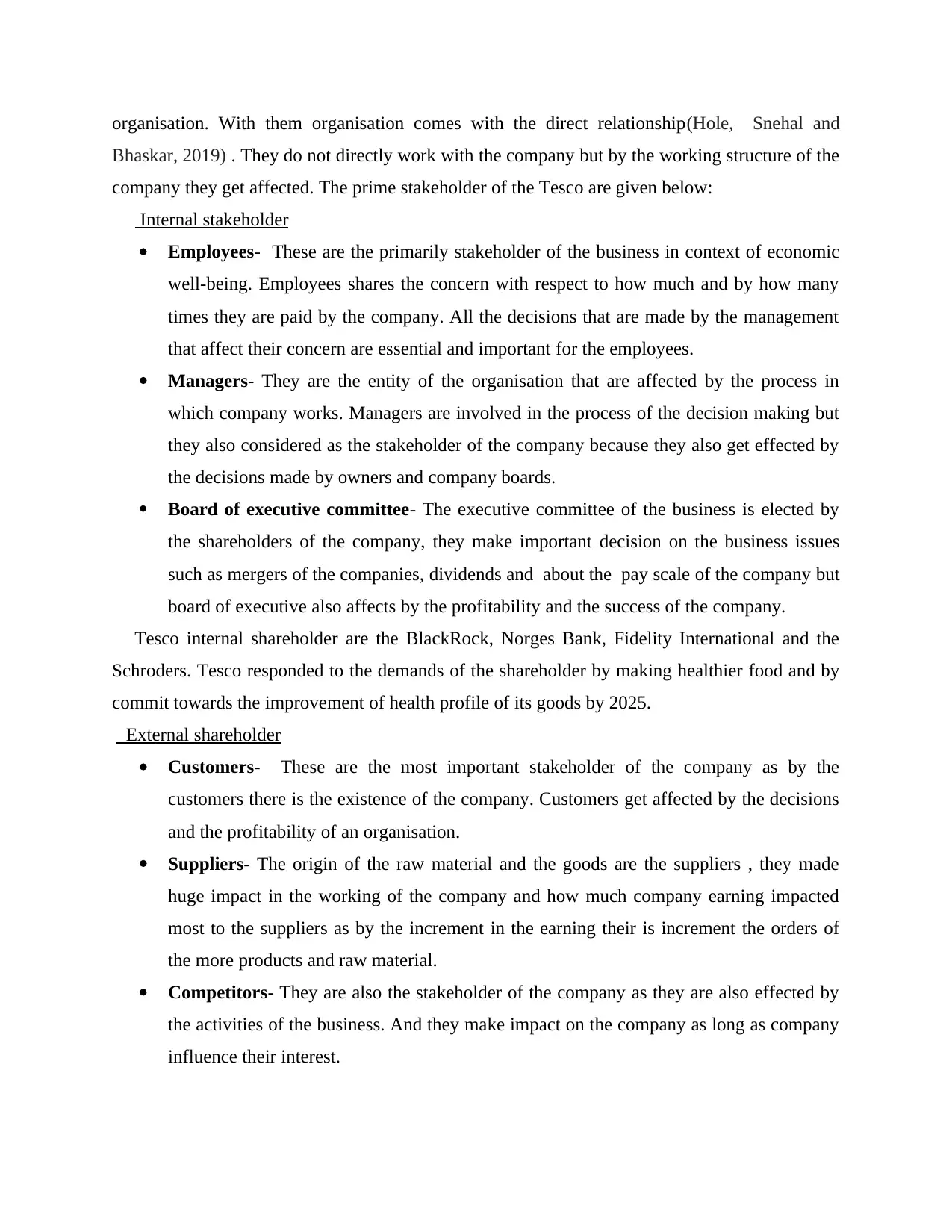
organisation. With them organisation comes with the direct relationship(Hole, Snehal and
Bhaskar, 2019) . They do not directly work with the company but by the working structure of the
company they get affected. The prime stakeholder of the Tesco are given below:
Internal stakeholder
Employees- These are the primarily stakeholder of the business in context of economic
well-being. Employees shares the concern with respect to how much and by how many
times they are paid by the company. All the decisions that are made by the management
that affect their concern are essential and important for the employees.
Managers- They are the entity of the organisation that are affected by the process in
which company works. Managers are involved in the process of the decision making but
they also considered as the stakeholder of the company because they also get effected by
the decisions made by owners and company boards.
Board of executive committee- The executive committee of the business is elected by
the shareholders of the company, they make important decision on the business issues
such as mergers of the companies, dividends and about the pay scale of the company but
board of executive also affects by the profitability and the success of the company.
Tesco internal shareholder are the BlackRock, Norges Bank, Fidelity International and the
Schroders. Tesco responded to the demands of the shareholder by making healthier food and by
commit towards the improvement of health profile of its goods by 2025.
External shareholder
Customers- These are the most important stakeholder of the company as by the
customers there is the existence of the company. Customers get affected by the decisions
and the profitability of an organisation.
Suppliers- The origin of the raw material and the goods are the suppliers , they made
huge impact in the working of the company and how much company earning impacted
most to the suppliers as by the increment in the earning their is increment the orders of
the more products and raw material.
Competitors- They are also the stakeholder of the company as they are also effected by
the activities of the business. And they make impact on the company as long as company
influence their interest.
Bhaskar, 2019) . They do not directly work with the company but by the working structure of the
company they get affected. The prime stakeholder of the Tesco are given below:
Internal stakeholder
Employees- These are the primarily stakeholder of the business in context of economic
well-being. Employees shares the concern with respect to how much and by how many
times they are paid by the company. All the decisions that are made by the management
that affect their concern are essential and important for the employees.
Managers- They are the entity of the organisation that are affected by the process in
which company works. Managers are involved in the process of the decision making but
they also considered as the stakeholder of the company because they also get effected by
the decisions made by owners and company boards.
Board of executive committee- The executive committee of the business is elected by
the shareholders of the company, they make important decision on the business issues
such as mergers of the companies, dividends and about the pay scale of the company but
board of executive also affects by the profitability and the success of the company.
Tesco internal shareholder are the BlackRock, Norges Bank, Fidelity International and the
Schroders. Tesco responded to the demands of the shareholder by making healthier food and by
commit towards the improvement of health profile of its goods by 2025.
External shareholder
Customers- These are the most important stakeholder of the company as by the
customers there is the existence of the company. Customers get affected by the decisions
and the profitability of an organisation.
Suppliers- The origin of the raw material and the goods are the suppliers , they made
huge impact in the working of the company and how much company earning impacted
most to the suppliers as by the increment in the earning their is increment the orders of
the more products and raw material.
Competitors- They are also the stakeholder of the company as they are also effected by
the activities of the business. And they make impact on the company as long as company
influence their interest.
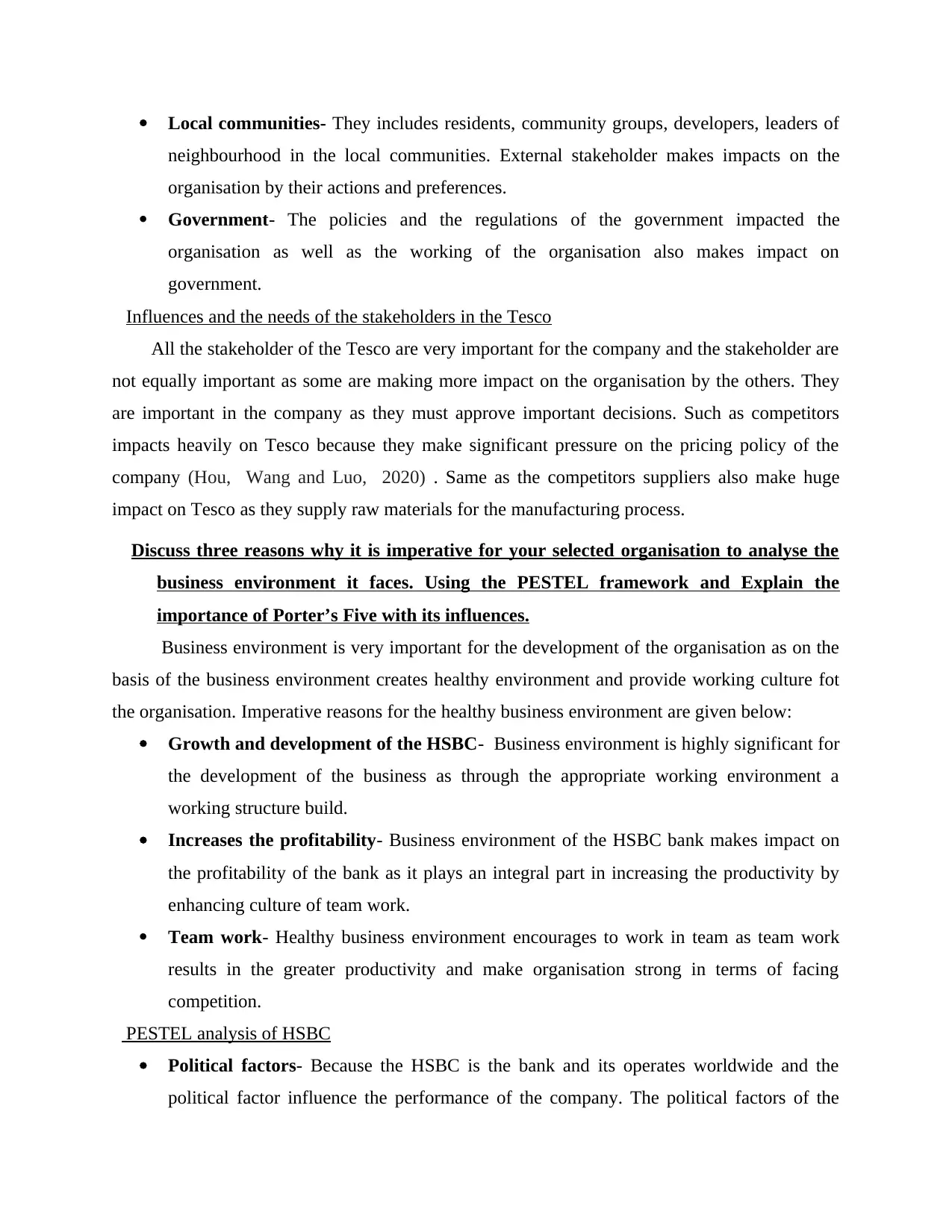
Local communities- They includes residents, community groups, developers, leaders of
neighbourhood in the local communities. External stakeholder makes impacts on the
organisation by their actions and preferences.
Government- The policies and the regulations of the government impacted the
organisation as well as the working of the organisation also makes impact on
government.
Influences and the needs of the stakeholders in the Tesco
All the stakeholder of the Tesco are very important for the company and the stakeholder are
not equally important as some are making more impact on the organisation by the others. They
are important in the company as they must approve important decisions. Such as competitors
impacts heavily on Tesco because they make significant pressure on the pricing policy of the
company (Hou, Wang and Luo, 2020) . Same as the competitors suppliers also make huge
impact on Tesco as they supply raw materials for the manufacturing process.
Discuss three reasons why it is imperative for your selected organisation to analyse the
business environment it faces. Using the PESTEL framework and Explain the
importance of Porter’s Five with its influences.
Business environment is very important for the development of the organisation as on the
basis of the business environment creates healthy environment and provide working culture fot
the organisation. Imperative reasons for the healthy business environment are given below:
Growth and development of the HSBC- Business environment is highly significant for
the development of the business as through the appropriate working environment a
working structure build.
Increases the profitability- Business environment of the HSBC bank makes impact on
the profitability of the bank as it plays an integral part in increasing the productivity by
enhancing culture of team work.
Team work- Healthy business environment encourages to work in team as team work
results in the greater productivity and make organisation strong in terms of facing
competition.
PESTEL analysis of HSBC
Political factors- Because the HSBC is the bank and its operates worldwide and the
political factor influence the performance of the company. The political factors of the
neighbourhood in the local communities. External stakeholder makes impacts on the
organisation by their actions and preferences.
Government- The policies and the regulations of the government impacted the
organisation as well as the working of the organisation also makes impact on
government.
Influences and the needs of the stakeholders in the Tesco
All the stakeholder of the Tesco are very important for the company and the stakeholder are
not equally important as some are making more impact on the organisation by the others. They
are important in the company as they must approve important decisions. Such as competitors
impacts heavily on Tesco because they make significant pressure on the pricing policy of the
company (Hou, Wang and Luo, 2020) . Same as the competitors suppliers also make huge
impact on Tesco as they supply raw materials for the manufacturing process.
Discuss three reasons why it is imperative for your selected organisation to analyse the
business environment it faces. Using the PESTEL framework and Explain the
importance of Porter’s Five with its influences.
Business environment is very important for the development of the organisation as on the
basis of the business environment creates healthy environment and provide working culture fot
the organisation. Imperative reasons for the healthy business environment are given below:
Growth and development of the HSBC- Business environment is highly significant for
the development of the business as through the appropriate working environment a
working structure build.
Increases the profitability- Business environment of the HSBC bank makes impact on
the profitability of the bank as it plays an integral part in increasing the productivity by
enhancing culture of team work.
Team work- Healthy business environment encourages to work in team as team work
results in the greater productivity and make organisation strong in terms of facing
competition.
PESTEL analysis of HSBC
Political factors- Because the HSBC is the bank and its operates worldwide and the
political factor influence the performance of the company. The political factors of the
⊘ This is a preview!⊘
Do you want full access?
Subscribe today to unlock all pages.

Trusted by 1+ million students worldwide
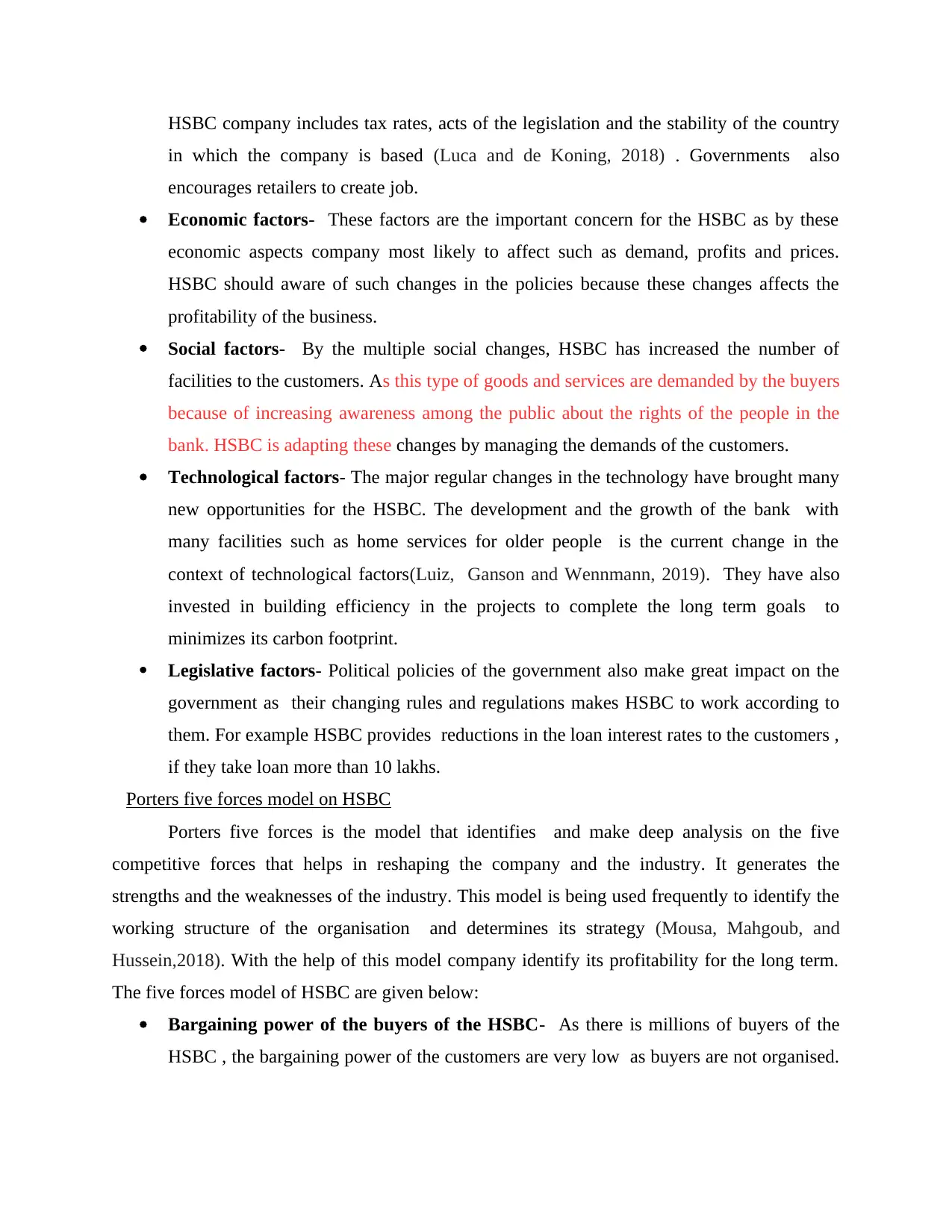
HSBC company includes tax rates, acts of the legislation and the stability of the country
in which the company is based (Luca and de Koning, 2018) . Governments also
encourages retailers to create job.
Economic factors- These factors are the important concern for the HSBC as by these
economic aspects company most likely to affect such as demand, profits and prices.
HSBC should aware of such changes in the policies because these changes affects the
profitability of the business.
Social factors- By the multiple social changes, HSBC has increased the number of
facilities to the customers. As this type of goods and services are demanded by the buyers
because of increasing awareness among the public about the rights of the people in the
bank. HSBC is adapting these changes by managing the demands of the customers.
Technological factors- The major regular changes in the technology have brought many
new opportunities for the HSBC. The development and the growth of the bank with
many facilities such as home services for older people is the current change in the
context of technological factors(Luiz, Ganson and Wennmann, 2019). They have also
invested in building efficiency in the projects to complete the long term goals to
minimizes its carbon footprint.
Legislative factors- Political policies of the government also make great impact on the
government as their changing rules and regulations makes HSBC to work according to
them. For example HSBC provides reductions in the loan interest rates to the customers ,
if they take loan more than 10 lakhs.
Porters five forces model on HSBC
Porters five forces is the model that identifies and make deep analysis on the five
competitive forces that helps in reshaping the company and the industry. It generates the
strengths and the weaknesses of the industry. This model is being used frequently to identify the
working structure of the organisation and determines its strategy (Mousa, Mahgoub, and
Hussein,2018). With the help of this model company identify its profitability for the long term.
The five forces model of HSBC are given below:
Bargaining power of the buyers of the HSBC- As there is millions of buyers of the
HSBC , the bargaining power of the customers are very low as buyers are not organised.
in which the company is based (Luca and de Koning, 2018) . Governments also
encourages retailers to create job.
Economic factors- These factors are the important concern for the HSBC as by these
economic aspects company most likely to affect such as demand, profits and prices.
HSBC should aware of such changes in the policies because these changes affects the
profitability of the business.
Social factors- By the multiple social changes, HSBC has increased the number of
facilities to the customers. As this type of goods and services are demanded by the buyers
because of increasing awareness among the public about the rights of the people in the
bank. HSBC is adapting these changes by managing the demands of the customers.
Technological factors- The major regular changes in the technology have brought many
new opportunities for the HSBC. The development and the growth of the bank with
many facilities such as home services for older people is the current change in the
context of technological factors(Luiz, Ganson and Wennmann, 2019). They have also
invested in building efficiency in the projects to complete the long term goals to
minimizes its carbon footprint.
Legislative factors- Political policies of the government also make great impact on the
government as their changing rules and regulations makes HSBC to work according to
them. For example HSBC provides reductions in the loan interest rates to the customers ,
if they take loan more than 10 lakhs.
Porters five forces model on HSBC
Porters five forces is the model that identifies and make deep analysis on the five
competitive forces that helps in reshaping the company and the industry. It generates the
strengths and the weaknesses of the industry. This model is being used frequently to identify the
working structure of the organisation and determines its strategy (Mousa, Mahgoub, and
Hussein,2018). With the help of this model company identify its profitability for the long term.
The five forces model of HSBC are given below:
Bargaining power of the buyers of the HSBC- As there is millions of buyers of the
HSBC , the bargaining power of the customers are very low as buyers are not organised.
Paraphrase This Document
Need a fresh take? Get an instant paraphrase of this document with our AI Paraphraser
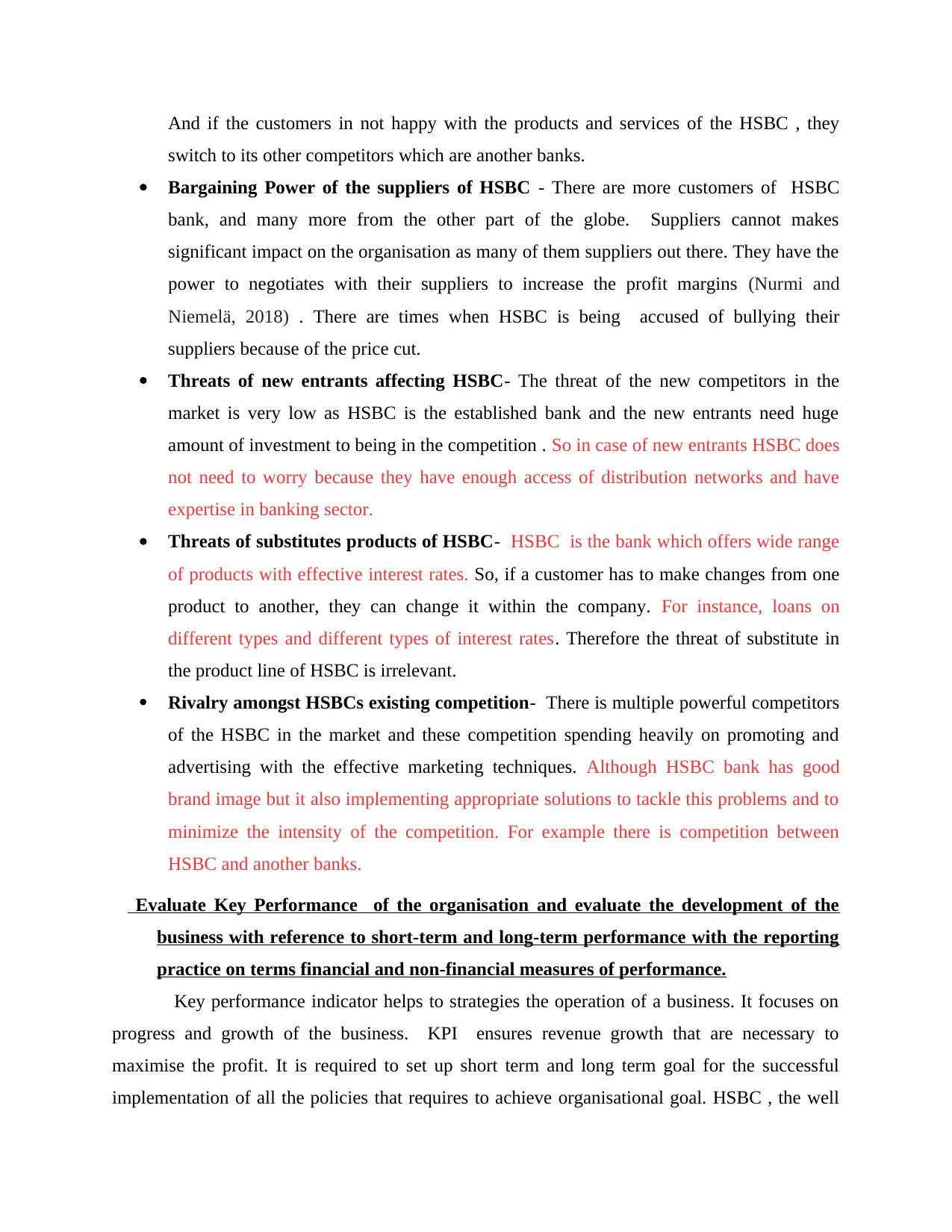
And if the customers in not happy with the products and services of the HSBC , they
switch to its other competitors which are another banks.
Bargaining Power of the suppliers of HSBC - There are more customers of HSBC
bank, and many more from the other part of the globe. Suppliers cannot makes
significant impact on the organisation as many of them suppliers out there. They have the
power to negotiates with their suppliers to increase the profit margins (Nurmi and
Niemelä, 2018) . There are times when HSBC is being accused of bullying their
suppliers because of the price cut.
Threats of new entrants affecting HSBC- The threat of the new competitors in the
market is very low as HSBC is the established bank and the new entrants need huge
amount of investment to being in the competition . So in case of new entrants HSBC does
not need to worry because they have enough access of distribution networks and have
expertise in banking sector.
Threats of substitutes products of HSBC- HSBC is the bank which offers wide range
of products with effective interest rates. So, if a customer has to make changes from one
product to another, they can change it within the company. For instance, loans on
different types and different types of interest rates. Therefore the threat of substitute in
the product line of HSBC is irrelevant.
Rivalry amongst HSBCs existing competition- There is multiple powerful competitors
of the HSBC in the market and these competition spending heavily on promoting and
advertising with the effective marketing techniques. Although HSBC bank has good
brand image but it also implementing appropriate solutions to tackle this problems and to
minimize the intensity of the competition. For example there is competition between
HSBC and another banks.
Evaluate Key Performance of the organisation and evaluate the development of the
business with reference to short-term and long-term performance with the reporting
practice on terms financial and non-financial measures of performance.
Key performance indicator helps to strategies the operation of a business. It focuses on
progress and growth of the business. KPI ensures revenue growth that are necessary to
maximise the profit. It is required to set up short term and long term goal for the successful
implementation of all the policies that requires to achieve organisational goal. HSBC , the well
switch to its other competitors which are another banks.
Bargaining Power of the suppliers of HSBC - There are more customers of HSBC
bank, and many more from the other part of the globe. Suppliers cannot makes
significant impact on the organisation as many of them suppliers out there. They have the
power to negotiates with their suppliers to increase the profit margins (Nurmi and
Niemelä, 2018) . There are times when HSBC is being accused of bullying their
suppliers because of the price cut.
Threats of new entrants affecting HSBC- The threat of the new competitors in the
market is very low as HSBC is the established bank and the new entrants need huge
amount of investment to being in the competition . So in case of new entrants HSBC does
not need to worry because they have enough access of distribution networks and have
expertise in banking sector.
Threats of substitutes products of HSBC- HSBC is the bank which offers wide range
of products with effective interest rates. So, if a customer has to make changes from one
product to another, they can change it within the company. For instance, loans on
different types and different types of interest rates. Therefore the threat of substitute in
the product line of HSBC is irrelevant.
Rivalry amongst HSBCs existing competition- There is multiple powerful competitors
of the HSBC in the market and these competition spending heavily on promoting and
advertising with the effective marketing techniques. Although HSBC bank has good
brand image but it also implementing appropriate solutions to tackle this problems and to
minimize the intensity of the competition. For example there is competition between
HSBC and another banks.
Evaluate Key Performance of the organisation and evaluate the development of the
business with reference to short-term and long-term performance with the reporting
practice on terms financial and non-financial measures of performance.
Key performance indicator helps to strategies the operation of a business. It focuses on
progress and growth of the business. KPI ensures revenue growth that are necessary to
maximise the profit. It is required to set up short term and long term goal for the successful
implementation of all the policies that requires to achieve organisational goal. HSBC , the well
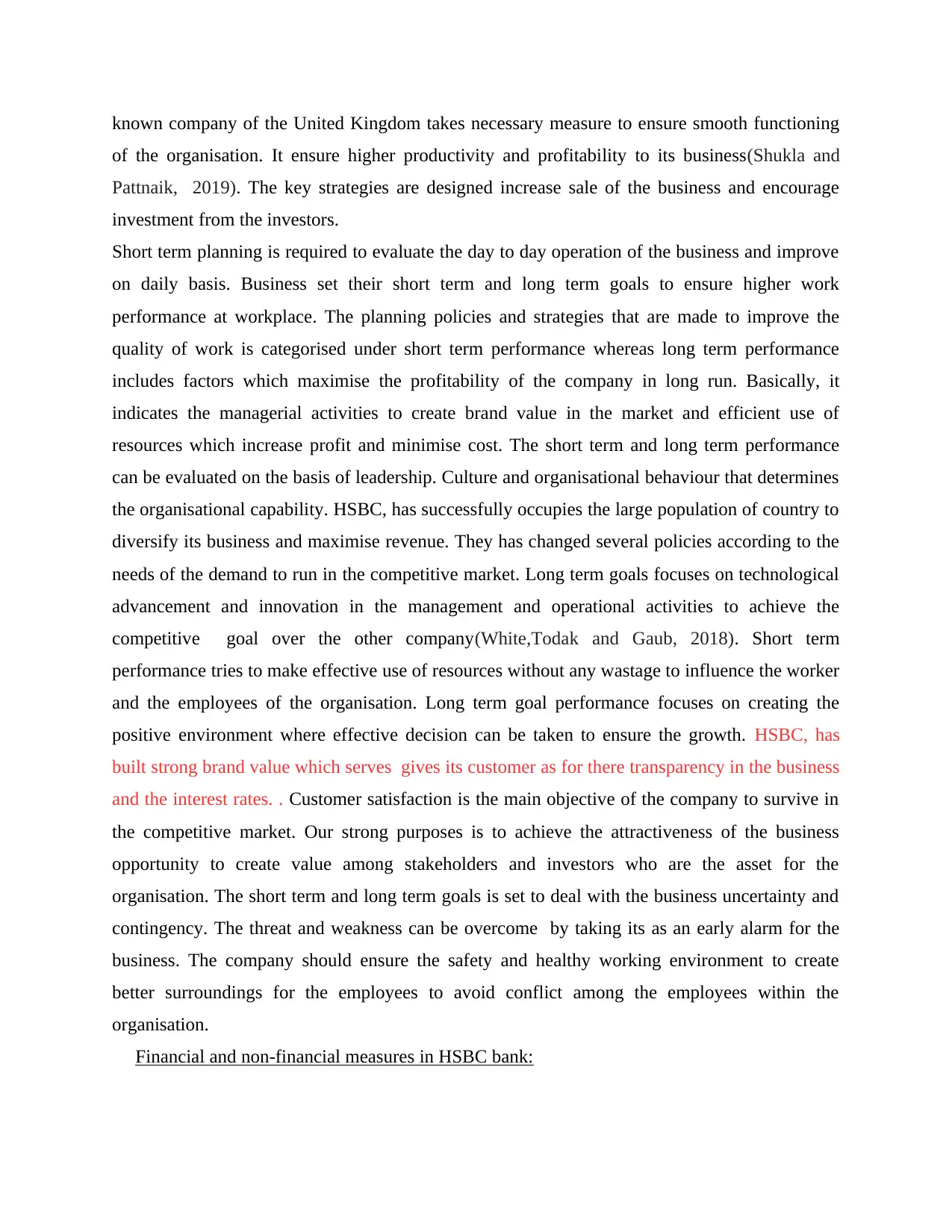
known company of the United Kingdom takes necessary measure to ensure smooth functioning
of the organisation. It ensure higher productivity and profitability to its business(Shukla and
Pattnaik, 2019). The key strategies are designed increase sale of the business and encourage
investment from the investors.
Short term planning is required to evaluate the day to day operation of the business and improve
on daily basis. Business set their short term and long term goals to ensure higher work
performance at workplace. The planning policies and strategies that are made to improve the
quality of work is categorised under short term performance whereas long term performance
includes factors which maximise the profitability of the company in long run. Basically, it
indicates the managerial activities to create brand value in the market and efficient use of
resources which increase profit and minimise cost. The short term and long term performance
can be evaluated on the basis of leadership. Culture and organisational behaviour that determines
the organisational capability. HSBC, has successfully occupies the large population of country to
diversify its business and maximise revenue. They has changed several policies according to the
needs of the demand to run in the competitive market. Long term goals focuses on technological
advancement and innovation in the management and operational activities to achieve the
competitive goal over the other company(White,Todak and Gaub, 2018). Short term
performance tries to make effective use of resources without any wastage to influence the worker
and the employees of the organisation. Long term goal performance focuses on creating the
positive environment where effective decision can be taken to ensure the growth. HSBC, has
built strong brand value which serves gives its customer as for there transparency in the business
and the interest rates. . Customer satisfaction is the main objective of the company to survive in
the competitive market. Our strong purposes is to achieve the attractiveness of the business
opportunity to create value among stakeholders and investors who are the asset for the
organisation. The short term and long term goals is set to deal with the business uncertainty and
contingency. The threat and weakness can be overcome by taking its as an early alarm for the
business. The company should ensure the safety and healthy working environment to create
better surroundings for the employees to avoid conflict among the employees within the
organisation.
Financial and non-financial measures in HSBC bank:
of the organisation. It ensure higher productivity and profitability to its business(Shukla and
Pattnaik, 2019). The key strategies are designed increase sale of the business and encourage
investment from the investors.
Short term planning is required to evaluate the day to day operation of the business and improve
on daily basis. Business set their short term and long term goals to ensure higher work
performance at workplace. The planning policies and strategies that are made to improve the
quality of work is categorised under short term performance whereas long term performance
includes factors which maximise the profitability of the company in long run. Basically, it
indicates the managerial activities to create brand value in the market and efficient use of
resources which increase profit and minimise cost. The short term and long term performance
can be evaluated on the basis of leadership. Culture and organisational behaviour that determines
the organisational capability. HSBC, has successfully occupies the large population of country to
diversify its business and maximise revenue. They has changed several policies according to the
needs of the demand to run in the competitive market. Long term goals focuses on technological
advancement and innovation in the management and operational activities to achieve the
competitive goal over the other company(White,Todak and Gaub, 2018). Short term
performance tries to make effective use of resources without any wastage to influence the worker
and the employees of the organisation. Long term goal performance focuses on creating the
positive environment where effective decision can be taken to ensure the growth. HSBC, has
built strong brand value which serves gives its customer as for there transparency in the business
and the interest rates. . Customer satisfaction is the main objective of the company to survive in
the competitive market. Our strong purposes is to achieve the attractiveness of the business
opportunity to create value among stakeholders and investors who are the asset for the
organisation. The short term and long term goals is set to deal with the business uncertainty and
contingency. The threat and weakness can be overcome by taking its as an early alarm for the
business. The company should ensure the safety and healthy working environment to create
better surroundings for the employees to avoid conflict among the employees within the
organisation.
Financial and non-financial measures in HSBC bank:
⊘ This is a preview!⊘
Do you want full access?
Subscribe today to unlock all pages.

Trusted by 1+ million students worldwide
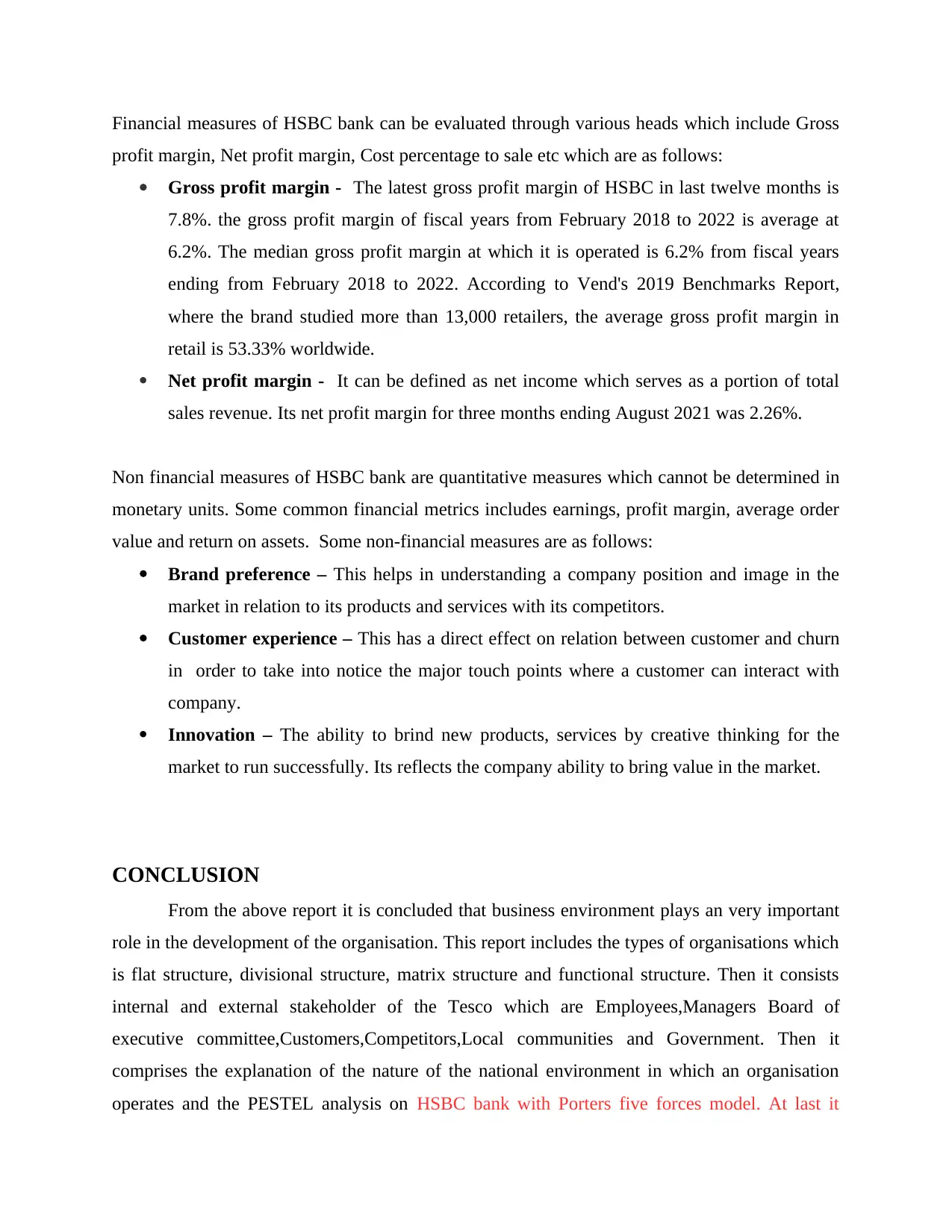
Financial measures of HSBC bank can be evaluated through various heads which include Gross
profit margin, Net profit margin, Cost percentage to sale etc which are as follows:
Gross profit margin - The latest gross profit margin of HSBC in last twelve months is
7.8%. the gross profit margin of fiscal years from February 2018 to 2022 is average at
6.2%. The median gross profit margin at which it is operated is 6.2% from fiscal years
ending from February 2018 to 2022. According to Vend's 2019 Benchmarks Report,
where the brand studied more than 13,000 retailers, the average gross profit margin in
retail is 53.33% worldwide.
Net profit margin - It can be defined as net income which serves as a portion of total
sales revenue. Its net profit margin for three months ending August 2021 was 2.26%.
Non financial measures of HSBC bank are quantitative measures which cannot be determined in
monetary units. Some common financial metrics includes earnings, profit margin, average order
value and return on assets. Some non-financial measures are as follows:
Brand preference – This helps in understanding a company position and image in the
market in relation to its products and services with its competitors.
Customer experience – This has a direct effect on relation between customer and churn
in order to take into notice the major touch points where a customer can interact with
company.
Innovation – The ability to brind new products, services by creative thinking for the
market to run successfully. Its reflects the company ability to bring value in the market.
CONCLUSION
From the above report it is concluded that business environment plays an very important
role in the development of the organisation. This report includes the types of organisations which
is flat structure, divisional structure, matrix structure and functional structure. Then it consists
internal and external stakeholder of the Tesco which are Employees,Managers Board of
executive committee,Customers,Competitors,Local communities and Government. Then it
comprises the explanation of the nature of the national environment in which an organisation
operates and the PESTEL analysis on HSBC bank with Porters five forces model. At last it
profit margin, Net profit margin, Cost percentage to sale etc which are as follows:
Gross profit margin - The latest gross profit margin of HSBC in last twelve months is
7.8%. the gross profit margin of fiscal years from February 2018 to 2022 is average at
6.2%. The median gross profit margin at which it is operated is 6.2% from fiscal years
ending from February 2018 to 2022. According to Vend's 2019 Benchmarks Report,
where the brand studied more than 13,000 retailers, the average gross profit margin in
retail is 53.33% worldwide.
Net profit margin - It can be defined as net income which serves as a portion of total
sales revenue. Its net profit margin for three months ending August 2021 was 2.26%.
Non financial measures of HSBC bank are quantitative measures which cannot be determined in
monetary units. Some common financial metrics includes earnings, profit margin, average order
value and return on assets. Some non-financial measures are as follows:
Brand preference – This helps in understanding a company position and image in the
market in relation to its products and services with its competitors.
Customer experience – This has a direct effect on relation between customer and churn
in order to take into notice the major touch points where a customer can interact with
company.
Innovation – The ability to brind new products, services by creative thinking for the
market to run successfully. Its reflects the company ability to bring value in the market.
CONCLUSION
From the above report it is concluded that business environment plays an very important
role in the development of the organisation. This report includes the types of organisations which
is flat structure, divisional structure, matrix structure and functional structure. Then it consists
internal and external stakeholder of the Tesco which are Employees,Managers Board of
executive committee,Customers,Competitors,Local communities and Government. Then it
comprises the explanation of the nature of the national environment in which an organisation
operates and the PESTEL analysis on HSBC bank with Porters five forces model. At last it
Paraphrase This Document
Need a fresh take? Get an instant paraphrase of this document with our AI Paraphraser
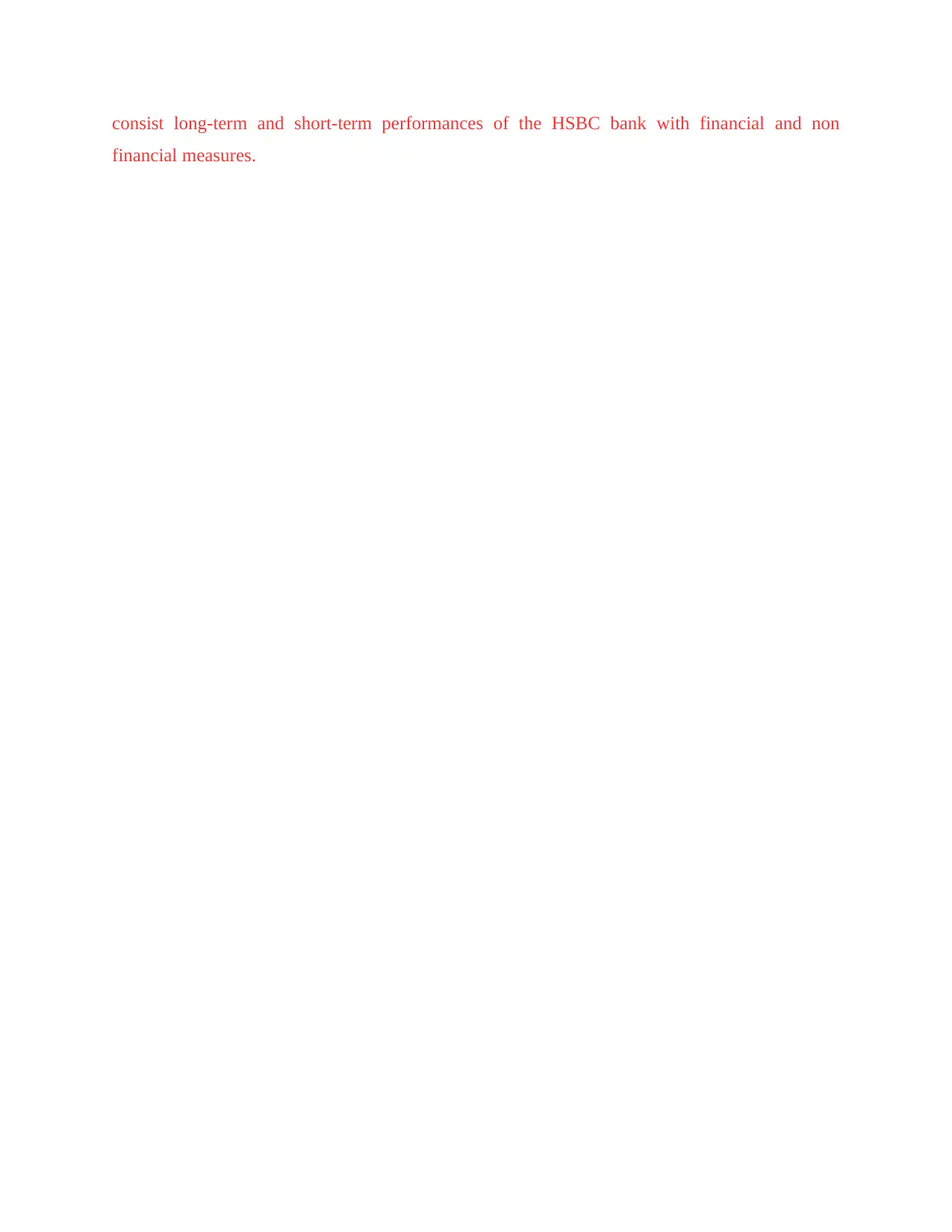
consist long-term and short-term performances of the HSBC bank with financial and non
financial measures.
financial measures.
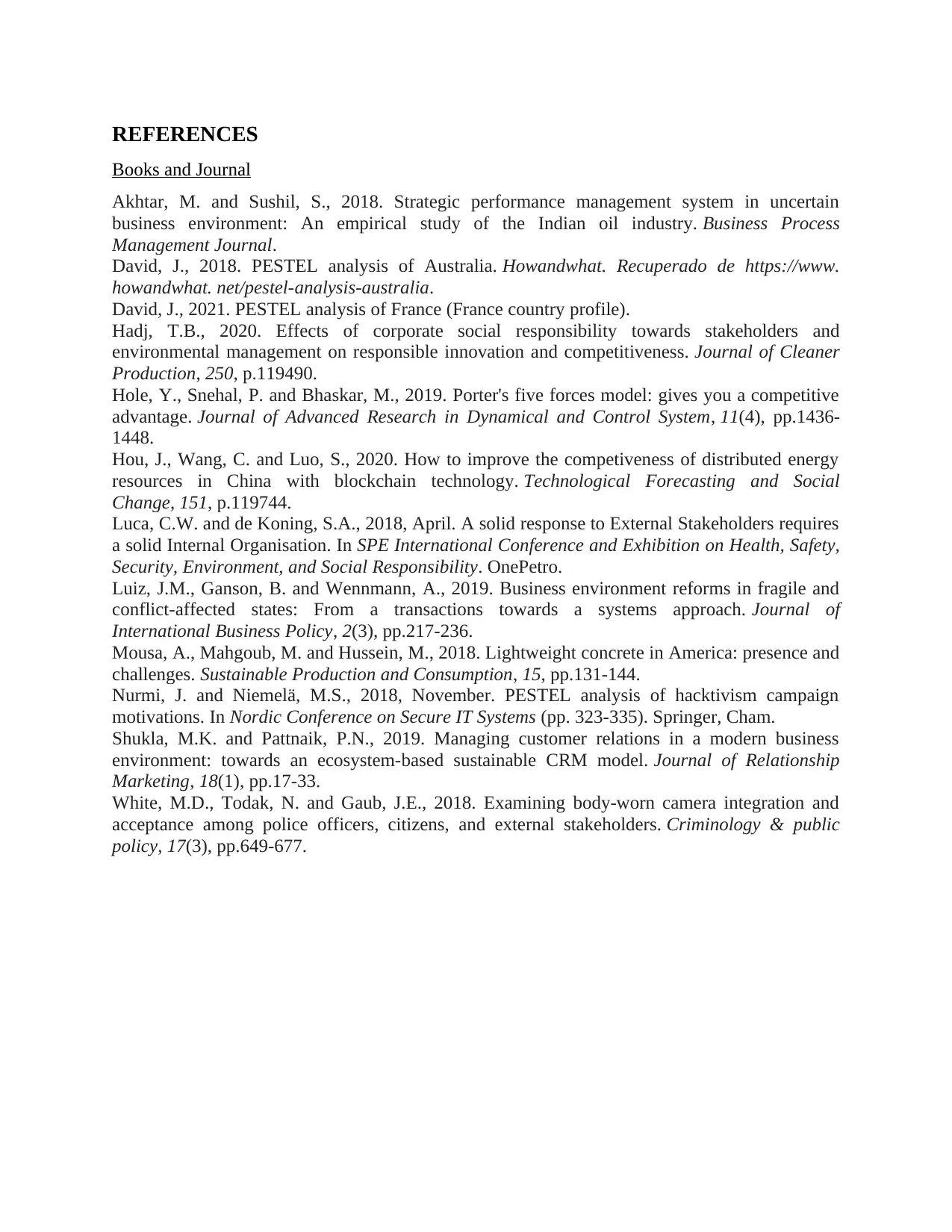
REFERENCES
Books and Journal
Akhtar, M. and Sushil, S., 2018. Strategic performance management system in uncertain
business environment: An empirical study of the Indian oil industry. Business Process
Management Journal.
David, J., 2018. PESTEL analysis of Australia. Howandwhat. Recuperado de https://www.
howandwhat. net/pestel-analysis-australia.
David, J., 2021. PESTEL analysis of France (France country profile).
Hadj, T.B., 2020. Effects of corporate social responsibility towards stakeholders and
environmental management on responsible innovation and competitiveness. Journal of Cleaner
Production, 250, p.119490.
Hole, Y., Snehal, P. and Bhaskar, M., 2019. Porter's five forces model: gives you a competitive
advantage. Journal of Advanced Research in Dynamical and Control System, 11(4), pp.1436-
1448.
Hou, J., Wang, C. and Luo, S., 2020. How to improve the competiveness of distributed energy
resources in China with blockchain technology. Technological Forecasting and Social
Change, 151, p.119744.
Luca, C.W. and de Koning, S.A., 2018, April. A solid response to External Stakeholders requires
a solid Internal Organisation. In SPE International Conference and Exhibition on Health, Safety,
Security, Environment, and Social Responsibility. OnePetro.
Luiz, J.M., Ganson, B. and Wennmann, A., 2019. Business environment reforms in fragile and
conflict-affected states: From a transactions towards a systems approach. Journal of
International Business Policy, 2(3), pp.217-236.
Mousa, A., Mahgoub, M. and Hussein, M., 2018. Lightweight concrete in America: presence and
challenges. Sustainable Production and Consumption, 15, pp.131-144.
Nurmi, J. and Niemelä, M.S., 2018, November. PESTEL analysis of hacktivism campaign
motivations. In Nordic Conference on Secure IT Systems (pp. 323-335). Springer, Cham.
Shukla, M.K. and Pattnaik, P.N., 2019. Managing customer relations in a modern business
environment: towards an ecosystem-based sustainable CRM model. Journal of Relationship
Marketing, 18(1), pp.17-33.
White, M.D., Todak, N. and Gaub, J.E., 2018. Examining body‐worn camera integration and
acceptance among police officers, citizens, and external stakeholders. Criminology & public
policy, 17(3), pp.649-677.
Books and Journal
Akhtar, M. and Sushil, S., 2018. Strategic performance management system in uncertain
business environment: An empirical study of the Indian oil industry. Business Process
Management Journal.
David, J., 2018. PESTEL analysis of Australia. Howandwhat. Recuperado de https://www.
howandwhat. net/pestel-analysis-australia.
David, J., 2021. PESTEL analysis of France (France country profile).
Hadj, T.B., 2020. Effects of corporate social responsibility towards stakeholders and
environmental management on responsible innovation and competitiveness. Journal of Cleaner
Production, 250, p.119490.
Hole, Y., Snehal, P. and Bhaskar, M., 2019. Porter's five forces model: gives you a competitive
advantage. Journal of Advanced Research in Dynamical and Control System, 11(4), pp.1436-
1448.
Hou, J., Wang, C. and Luo, S., 2020. How to improve the competiveness of distributed energy
resources in China with blockchain technology. Technological Forecasting and Social
Change, 151, p.119744.
Luca, C.W. and de Koning, S.A., 2018, April. A solid response to External Stakeholders requires
a solid Internal Organisation. In SPE International Conference and Exhibition on Health, Safety,
Security, Environment, and Social Responsibility. OnePetro.
Luiz, J.M., Ganson, B. and Wennmann, A., 2019. Business environment reforms in fragile and
conflict-affected states: From a transactions towards a systems approach. Journal of
International Business Policy, 2(3), pp.217-236.
Mousa, A., Mahgoub, M. and Hussein, M., 2018. Lightweight concrete in America: presence and
challenges. Sustainable Production and Consumption, 15, pp.131-144.
Nurmi, J. and Niemelä, M.S., 2018, November. PESTEL analysis of hacktivism campaign
motivations. In Nordic Conference on Secure IT Systems (pp. 323-335). Springer, Cham.
Shukla, M.K. and Pattnaik, P.N., 2019. Managing customer relations in a modern business
environment: towards an ecosystem-based sustainable CRM model. Journal of Relationship
Marketing, 18(1), pp.17-33.
White, M.D., Todak, N. and Gaub, J.E., 2018. Examining body‐worn camera integration and
acceptance among police officers, citizens, and external stakeholders. Criminology & public
policy, 17(3), pp.649-677.
⊘ This is a preview!⊘
Do you want full access?
Subscribe today to unlock all pages.

Trusted by 1+ million students worldwide
1 out of 12
Related Documents
Your All-in-One AI-Powered Toolkit for Academic Success.
+13062052269
info@desklib.com
Available 24*7 on WhatsApp / Email
![[object Object]](/_next/static/media/star-bottom.7253800d.svg)
Unlock your academic potential
Copyright © 2020–2025 A2Z Services. All Rights Reserved. Developed and managed by ZUCOL.





